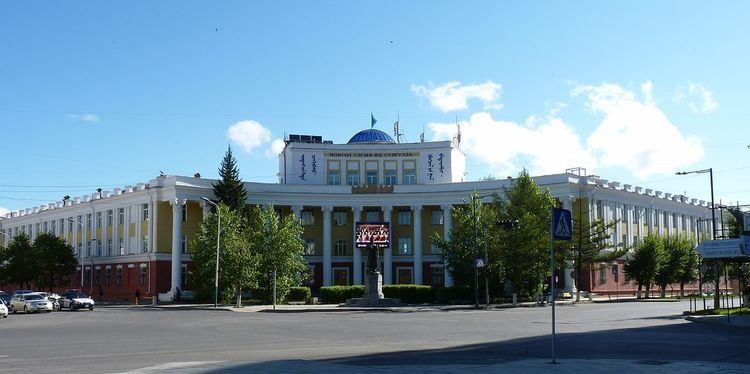Established 1942 Academic staff 589 Phone +976 8555 0925 Founded 1942 | President Bat-Erdene.R Total enrollment 10,017 (2010) Undergraduates 8,556 | |
 | ||
Motto Эрдмийн хэт цахиваас, хөгжлийн гал бадармойFrom education, the flame of progress flourishes Type public comprehensive university Undergraduate tuition and fees International tuition: 1,800 USD (2006) Notable alumni Zandaakhüügiin Enkhbold, Baabar, Norovyn Altankhuyag, Chimed Saikhanbileg, Sengiin Erdene Similar Mongolian University of Scienc, University of the Humanities, Mongolia International University, Bangladesh National University, Buryat State University Profiles | ||
The National University of Mongolia (Mongolian: Монгол Улсын Их Сургууль, Mongol Ulsyn Ikh Surguuli, abbreviated NUM or MUIS) is the oldest university in Mongolia. This public university is named after Marshal Khorloogiin Choibalsan and hosts twelve schools and faculties in Ulaanbaatar, and runs branches in the Zavkhan and Orkhon Aimags. Approximately one third of the academically educated Mongolians have graduated from NUM.
Contents
Mongolia's first secondary school was established in 1921. It was hence necessary to bring in an academic institution at an even higher level. In 1942, the Government put forth Mongolia's first university, the National University of Mongolia, with the first students graduating in 1946. During socialism, the University served as a training center for the party elite. Education was paid for and strictly controlled by the state. After democratization, it gradually changed into a more modern university. In 1995, it started to offer bachelor's, master's, and PhD programs.
In 2006, there were 12,000 students enrolled, including 2,000 graduate students. The university offers over 80 undergraduate and graduate programs, mostly in Mongolian.
History
The National University of Mongolia was established on October 5, 1942, as the first modern university in Mongolia. The faculties were initially Pedagogy, Medicine, and Veterinarian Sciences. Agriculture, Natural Sciences, Mongolian Studies, Foreign Languages, as well as research activities were added shortly thereafter. Part of its operation were supported by staff and materials provided by the Soviet Union.
Some of these initial faculties spun off into separate universities, including the Agricultural University in 1958, the Medical University in 1961, as well as the Technical University and the University of Humanities in 1982.
In 1942, 93 students and 53 students enrolled to the preparation course in the University, and the first graduation was held in 1946, with 35 students.
In 1959, the rectorate of the university was changed to the Mongolian party. Namsrain Sodnom, a graduate of the university, was appointed as the first Mongolian president, while Ts. Sürenkhorloo was appointed as the vice-president for academic affairs.
In 1947, a postgraduate faculty was founded in order to prepare university lecturers and scientists.
In 1994, 13 students were awarded master's degrees. In 1997, the department of postgraduate affairs was established with the purpose to increase the number of postgraduate students.
Main faculties
Main faculties
Memberships and cooperations
NUM is a member of the following organizations:
It has cooperation agreements with more than 242 academic and research centers all over the world.
